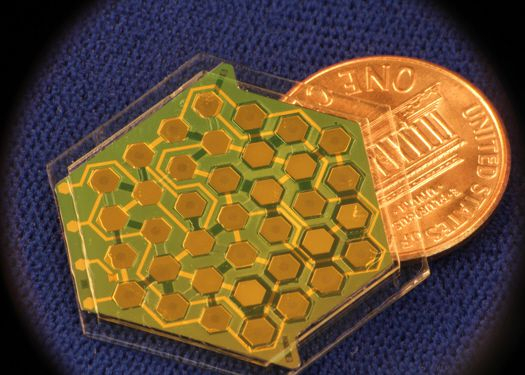
Way back in 2008, US defense research agency DARPA challenged the researchers to create a tiny vacuum system that can act as chemical sensor to sniff out chemical weapons and its size should not be more than a penny or smaller than a cubic centimeter. Its power usage should not be more than a quarter-Watt of energy.
Researchers at University of Michigan, MIT, and Honeywell International have plunged into the challenge and each come up with their micromachines meant for scaling down chemical sensors. Unlike mass spectrometers that identify chemicals by using big vacuum chambers to measure their mass, the micro device only needs to measure a few molecules, hence its vacuum chambers are made to be incredibly small.
Here is the model developed by the University of Michigan, featuring hexagonal chambers and a connecting series of pumps and valves. The miniaturized vacuum pump is a 24-stage peristaltic microscale rough pump, called the Honeycomb Michigan Pump.
It uses tiny micromachined hexagonal membranes in series configuration, each element of the array is either a pump or a valve. "These ultrathin electrostatically vibrating hexagonal membranes along with their tiny vacuum chambers form a scalable honeycomb configuration to pressurize or depressurize gases in a few seconds using only few milliwatts of electric power," explains the team.
Known to be one of the fastest gas micropumps to date, its design produces a large flow rate of 0.36 cc/minute and evacuates a sample chamber to about 97 kPa from the atmospheric pressure of 101.3 kPa, whereas the theoretical limit of such pump is to reduce the pressure to around 1.5 kPa.
The vacuum pump can be developed at low cost using conventional microfabrication techniques, and can be integrated with a variety of consumer-based microelectronic devices, said the team of developers from UM.
Its military usage is far more interesting. It can be fitted on a micro-drone and be used in conflict zones to detect the usage of chemical weapons. However, when the technology takes the route of common usage, it may transform even smartphones into a variety of other unknown uses such as sniffing out bad odor, gas leak in kitchen, and as DARPA programmer Andrei Shkel anticipates, in atomic clocks, which need vacuums to function.









